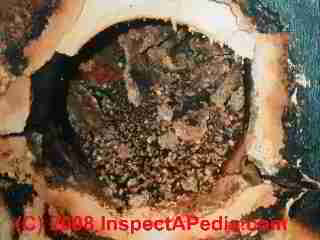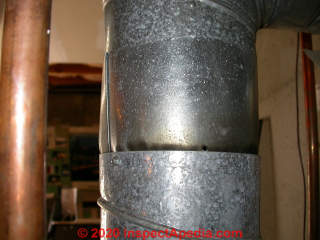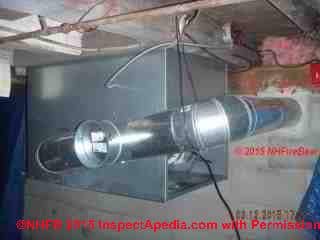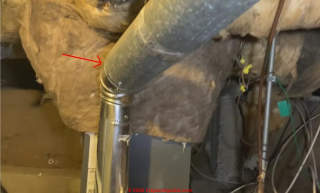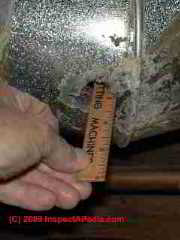 Flue Vent Connectors / Stackpipes for Heating Boilers, Furnaces, Water Heaters & Chimney Flues
Flue Vent Connectors / Stackpipes for Heating Boilers, Furnaces, Water Heaters & Chimney Flues
Horizontal & sloped connections between heating appliances & chimneys: materials, sizes, lengths, codes
- POST a QUESTION or COMMENT about metal flue vent connectors or "stackpipes"
Flue vent connector specifications & fire clearances: this article describes flue vent connectors used to connect heating appliances to a chimney in order to safely deliver combustion gases to a chimney for venting outside the building.
Flue vent connectors are not the same thing as a chimney and they have their own safety and installation requirements including slope, materials, diameter, and clearance from combustibles.
InspectAPedia tolerates no conflicts of interest. We have no relationship with advertisers, products, or services discussed at this website.
- Daniel Friedman, Publisher/Editor/Author - See WHO ARE WE?
Flue Vent Connectors - Heating Boilers, Furnaces, Water Heaters & Chimney Flues
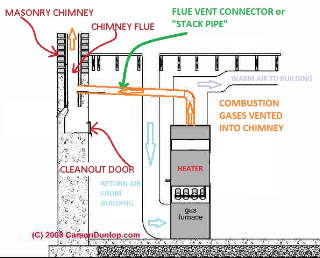 A flue vent connector or "stackpipe" (orange in our sketch) is the term used to describe the round metal vent or connection pipe connected between the combustion gas exhaust port of an oil or gas fired heater or a wood or coal stove and the chimney that ultimately vents the combustion gases to the outdoors.
A flue vent connector or "stackpipe" (orange in our sketch) is the term used to describe the round metal vent or connection pipe connected between the combustion gas exhaust port of an oil or gas fired heater or a wood or coal stove and the chimney that ultimately vents the combustion gases to the outdoors.
[Click to enlarge any image]
Our page top photo shows three separate heating appliances, each with its own flue-vent connector, connecting into (what we hope are) three individual flues in a masonry chimney. But from the layout we suspect these three heaters are sharing a common flue.
The wood and oil fired appliances should not share a chimney, as NHFireBear comments at SHARED CHIMNEY & FLUE HAZARDS.
Article Contents:
- FLUE VENT CONNECTORS, HEATING EQUIPMENT
- DEFINITIONS: Chimney, B vent, L vent, Gas Vent, & Flue Vent Connector -discussed here
- BLOCKED CHIMNEY AT THE FLUE VENT CONNECTOR
- EXTENDED TOO FAR INTO CHIMNEY
- JOINT CONNECTIONS - SINGLE WALL METAL FLUES
- LENGTH LIMITS FOR A FLUE VENT CONNECTOR
- LOOSE, LEAKY, NOT SEALED, FLUE VENT CONNECTOR
- MATERIAL, METAL TYPE for FLUES & FLUE VENT CONNECTORS
- RUSTED METAL FLUE VENT CONNECTORS
- SLOPE, PROPER FLUE VENT CONNECTORS
Definitions of Chimney, Factory-Built Chimney, & Flue Vent Connector
Because some readers may be confused about the difference between a "chimney" and a "flue vent connector" we include some simple definitions below. On our illustration at left we have marked the chimney, chimney flue, and flue vent connector - adapted from a Carson Dunlop Associates illustration used later in this article.
These definitions are important because the construction, use, and safety requirements as well as building codes and standards and fire clearances are different for these different components.
A Vent connector or flue vent connector or stackpipe or heating system ventpipe (as applying to heating) refers to that part of a venting system that conducts the flue gases or vent gases from the flue collar of a gas appliance to the chimney or gas vent , and may include a draft control device. - adapted from California building code, http://www.nationalcodes.nrc.gc.ca 11/13/2013
A Chimney means a primarily vertical shaft enclosing at least one flue for conducting flue gases to the outdoors.
FA actory-built chimney means a chimney consisting entirely of factory-made parts, each designed to be assembled with the other without requiring fabrication on site.
Flue vent connectors for "B" or "L" Vents: A vent connector connects gas equipment to a flue or chimney.
Appliances having draft hoods and installed in an attic or concealed space must use Type B or L connectors. Appliances installed in basements can use Type B or Type L or metal pipe (.0304" thick) or aluminum pipe (.012" thick). Gas fired equipment should not be connected to any flue serving solid fuel appliances.
Multiple gas vents into a single flue: Where two or more vent connectors enter a common gas vent, chimney flue or single wall metal pipe, the smaller connector shall enter at the highest level consistent with available headroom and clearance to combustibles. Avoid unnecessary bends and secure all joints with sheet metal screws or other approved means.
Chimney Blocked at the Flue Vent Connector
Watch out: Debris falling down a "dead end flue" easily blocks the flue vent connection and chimney (illustrations below). The result can be rapid and fatal
CARBON MONOXIDE - CO poisoning of building occupants. .
Carson Dunlop Associates [at REVIEWERS] sketch (above) shows fallen bricks blocking the bottom of the flue so that even where a "dead end" flue was not constructed - that is, where a chimney cleanout was installed - falling debris can so fill up the chamber at the bottom of the chimney flue that the effect is the same: a blocked chimney flue and the production of carbon monoxide.
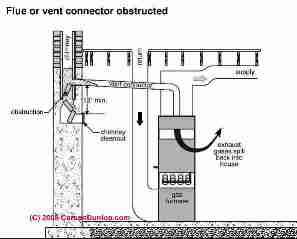
A blocked flue case study is reported
Flue Vent Connector Too Far into Chimney

Carson Dunlop Associates [at REVIEWERS] sketch shows what happens if the flue vent connector is jammed too far into the chimney flue.
Draft may be blocked, resulting in improper and potentially dangerously unsafe heating equipment operation.
For example, inadequate draft on a gas fired appliance makes the production of potentially fatal carbon monoxide gas likely.
The symptoms of this mistake are about the same as a blocked flue, and like a blocked flue, the diagnosis requires some disassembly and inspection of the flue vent connector and chimney by an expert.
Proper Joint Connections for Single Wall Metal Flue Vent Pipes

Metal flue vent connectors such as shown in Carson Dunlop Associates [at REVIEWERS] sketch (above left) should also be joined with the female (wider) ends facing "up" so that condensate and creosote that may form inside of the flue connector remain inside of the flue pipe.
Our photo just above shows that foil tape was used to join two flue vent connector pipes of different diameters from a gas fired heating appliance (not shown).
Foil tape is not a suitable substitute for the necessary adapter to join the two different diameter flue vent connectors.
It's easy to spot an improperly-joined flue vent connector pair of sections: you will often see stains from leaks oozing out at the section joints - as shown in our photo below.
Watch out: the flue vent connection shown above is improperly-made (female-to-male connection types are reversed with respect to the direction of flue gas exhaust flow) and is unsafe, risking flue gas leaks and carbon monoxide poisoning.
Flue vent connector horizontal length limits
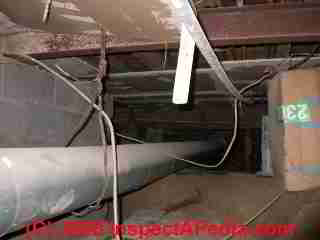 Horizontal vent length limits:
The horizontal length of a vent connector to a natural draft chimney or
vent serving a single draft hood appliance shall not be more that 75% of the
height of the vertical portion of the chimney above the connector. [NFPA 1992
(7.10.10)].
Horizontal vent length limits:
The horizontal length of a vent connector to a natural draft chimney or
vent serving a single draft hood appliance shall not be more that 75% of the
height of the vertical portion of the chimney above the connector. [NFPA 1992
(7.10.10)].
We show some long flue vent connector runs at
and at
FIRE CLEARANCES, METAL CHIMNEYS
The maximum horizontal length of vent connectors per the GAMA tables is limited to 1.5 feet per inch of diameter with a provision of a 10% reduction in capacity for each multiple of the length permitted. The venting tables must be consulted to size an adequate venting system.
Watch out: allowable flue vent connector length calculation can be a bit more complex than that rule of thumb, as the Q&A below illustrates.
Our photo shows a very long dead flue vent connector joining a heating appliance to a dead end chimney.
Reader Question: is there a Simple rule that relates allowable horizontal flue length and flue vent diameter?
What is the maximux allowable horizontal length of a category 1 appliance vent connector in feet for each inch of its diameter. - S.W.
Reply: Not quite so simple, here are the factors that determien allowable horizontal flue length:
From your question, a simple, straight answer on allowable flue length per inch of flue diameter is not quite possible. Take a look at the National Fuel Gas Code NFPA 54, or ANSI Z223.1, for example, Tables G, and you'll see that the tables consider the following factors that set the allowable horizontal flue length or run:
- the height or flue vent connector rise and/or chimney height
- the lateral distance (0, 2', 6', 12', up to 100 feet), flue diameter
- the number of appliances served
- the maximum appliance BTUH input rate of the appliance(s)
An example (from a 1988 copy of the National Fuel Gas Code):
a 6" diameter Type B double wall connector with a 15' lateral run and a 15' high chimney can vent 198,000 BTUh of capacity.
So a simplistic equation that gives allowable horizontal distance of a flue vent connector or vent expressed in feet per inch of diameter simply would be wrong and potentially unsafe, risking a carbon monoxide or equipment operating problem.
You will want to consult the proper tables either in one of the codes or in the heating equipment manufacturer's equipment installation procedures (the manufacturer would be expected to have the final say).
Reader Question: what's the code on distance and clearance for metalbestos chimneys & vents vs oil storage tanks?
I am installing a pellet boiler and will need a second metal chimney as I am leaving my oil burner as a backup. I live in maine. The only place I would like the metal asbestos chimney would run 40” away from my oil tank. Do you know what the code is on this? I am having a heck of a time getting any answers regarding this? - R. B. Windham ME 2/27/2014
Reply: heat flue vent length maximum distances vs. clearance distances from oil tanks or other building features
R.B. If you are asking about the chimney itself, insulated metal chimneys typically require a one-inch clearance from combustibles.
- The required separeation or clearance distances for flue vent connectors (generally single-wall uninsulated metal "flue pipes" or "stack pipes" that connect the heater to the chimney) is discussed
at FLUE VENT CONNECTORS, HEATING EQUIPMENT - The required separation of metal or insulated chimneys themselve from varous building components or combustibles is explained
at FIRE CLEARANCES, METAL CHIMNEYS and
for height above roofs,
see CHIMNEY HEIGHT & CLEARANCE CODE - The required separation of heating appliances (like an oil burner) from heating oil storage (the oil tank) is elaobrated
at ABOVE GROUND OIL STORAGE TANK (AST) INSPECTION
If you were asking about the distance or run length for the flue vent connector between the chimney and the heating appliance, that's a different story.
Suppose we wanted to run across an entire building from the heater to the chimney: the maximum horizontal length should not be more than 75% of the chimney height above the vent connector, or 100% if the chimney is insulated.
So to cross a 40 foot basement from a heater to a chimney you'd need a chimney at least 40 feet tall for the system to vent properly by natural draft. But an option that may work acceptably in that case is to include a draft inducer fan such as the type made by Field Controls.
Flue Vent Connector Loose, Leaky, Not Sealed at Chimney
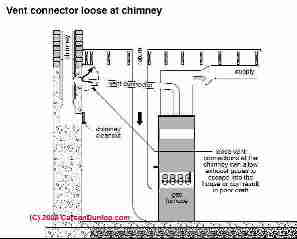
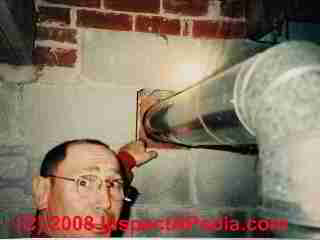
Carson Dunlop Associates [at REVIEWERS] sketch (above left) shows a loose flue vent connector at the chimney. This is one of the most common chimney and venting defects we observe in buildings.
This defect can often be seen by careful visual inspection of the flue vent connector at the chimney. Our photo (above right) shows our client pointing to a flue vent connector that was not sealed at the chimney thimble.
The results of a loose or leaky vent connection at the chimney include inadequate chimney draft (unsafe heater operation) and leakage of potentially dangerous combustion gases into the building.
Flue Vent Connector Materials
Conventional gas or oil fired heating appliances can be connected to their chimney (by a flue vent connector) using approved, listed materials such as stainless steel or galvanized steel.
Photo above: a gavanized steel flue vent connector for an oil fired heater, courtesy of NH Firebear. [Click to enlarge any image]
Enlarge the image and you'll see our red arrows pointing out that this is an unsafe flue vent installatin as it passes too close to combustible (wood) framing.
Really? Well not always. Some direct-vent high-efficiency heating equipment produces a cool exhaust that is vented through plastic piping. Those heaters and vents are discussed separately
at CONDENSING BOILERS/FURNACES
Watch out: DO not vent heating appliance combustion gases using aluminum (which was instead intended for clothes dryer exhaust ducting).
Question: do I need to insulate this exhaust duct? [Flue Vent Connector]
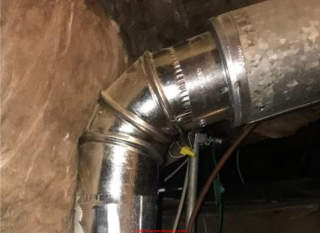 Does the furnace exhaust air duct need insulation?
Does the furnace exhaust air duct need insulation?
It's located in the basement.
It has a portion of new metal duct connecting to the old duct, as shown in the attached photos(red arrow). I wonder if this will cause galvanic corrosion?
Thank you for your kind advice! - Anonymous by private email 2020/05/16
Moderator reply:
Are we discussing a heating supply or return air duct or the acutal gas or oil fired heater's exhaust gas connector to chimney?
If it's an exhaust for the combustion gases, that is, a flule vent connector, then it should not be insulated, it needs to meet cleareances from combustibles, be properly sized, and of proper materials and with safe connections - discussed in this article series.
Watch out: is the metal used for the "duct" shown in your photos stainless steel, galvanized steel, or aluminum?
Reader follow-up:
It's exhaust duct to the chimney.
The technician does not know what metal it is. He just bought from the dealer. Is there any way to tell or find out what metal it is?
The joint is sealed with aluminum foil.
The furnace is Goodman GMES80-U
Moderator reply:
Let's don't call vents ducts as it's confusing people and may miss important safety concerns.
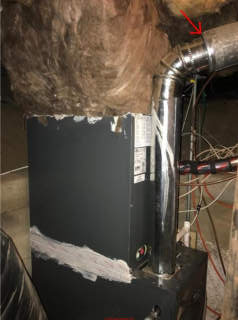 Watch out: It is important, for an exhaust vent connection to a chimney NOT be made of aluminum.
Watch out: It is important, for an exhaust vent connection to a chimney NOT be made of aluminum.
The risk is corrosion and carbon monoxide leaks and fatal CO poisoning.
Stainless steel or galvanized steel are OK if properly sized and connected.
In your photos the flue vent connector that's new and shiny looks to me, sitting far away and relying on just photos, like shiny galvanized steel.
Check out the embossed stamping on that connector that joins the new (smaller diameter) vent pipe to the older (larger-diameter) galvanized steel vent connector.
If your installer can't find a receipt for purchase, remember exactly what was bought, find a tag on the actual metal sections, or tell the difference between aluminum (soft, easy to bend with one's bare hands) and stainless steel, then you need someone more competent on site.
Watch out: the installation of our furnace and its venting look "off" to me.
What's that whhite goop painted along connections between the upper supply air plenum and the top of the furnace?
That's not an area that should have any kind of leaking and if there were a leak, blobbing on white stuff does not look to me like a professional, safe job.
And what's the material that the flue vent connector is up against - touching - in the upper left of your last photo of the whole system?
There may be a fire hazard or risk of damage to the insulation.
Unsafe Rusted Hole in Metal Flue Vent Connectors
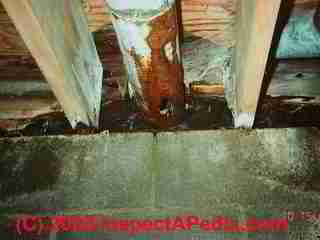
We suspect that the root cause of this unsafe metal heating flue is that it was routed out of the building at or below ground level - into a dead-end chimney.
Water from roof spillage or surface runoff have rusted out the flue vent connector.
This is an unsafe installation even before we think about the added hazards of fire clearances and adequate draft.
This flue vent connector (photo at left) has rusted through from water leaking down the chimney into the vent connector elbow.
On an oil-fired system we expect soot to blow out of this opening at system startup and during the system run cycle the opening may interfere with proper system draft. The opening leaves a fire risk should a spark blow out of this opening.
On a gas-fired system a flue vent connector with a rust hole increases the chance of inadequate draft and dangerous carbon monoxide release in the building.
This flue vent connector elbow,rusted through with a large hole, needs to be replaced and more, we need to identify and repair the source of water leakage into the chimney that caused this damage.
Proper Flue Vent Connector Slope
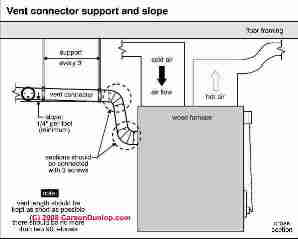
Metal flue vent connectors such as shown in Carson Dunlop Associates [at REVIEWERS] sketch should:
- slope upwards from the heating appliance to the chimney connection at no less than 1/4" per foot of horizontal run
- be kept as short as possible - long runs get cool, produce condensate, soot and debris and rust and clogging
- have flue pipe sections joined by three screws (two screw joints easily separate to vent dangerous flue gases into the building.
- Also see METAL CHIMNEY SLOPE LIMITS and
see DRAFT REGULATOR, DAMPER, BOOSTER
...
Reader Comments, Questions & Answers About The Article Above
Below you will find questions and answers previously posted on this page at its page bottom reader comment box.
Reader Q&A - also see RECOMMENDED ARTICLES & FAQs
On 2020-09-01 by Melissa
Thank you for your time and your response. I will take your advice.
On 2020-09-01 - by (mod) - metal flue vent connector runs underground: unsafe
What you describe is not a reliable nor safe venting system. See what a certified chimney expert can suggest as a redesign.
On 2020-09-01 by Melissa
I have a 60+ yr old house with a 16 ft. lateral flue running from the boiler (we have oil) to the exterior chimney.
A portion of the flue runs under a three season room the other half is buried under 6 inches of soil. (section closest to the chimney) During heavy rain we have approx. 50+ gal of water come out the boiler flue and boiler itself flooding the basement.
Is it possible to excavate the exterior portion of flue and cover it with a sealant as I am pretty certain the flue must have several cracks to allow that much water to flow into the boiler. Can lateral flues be replaced or repaired?
The flue was just cleared last year of several years of soot build up causing puff back. It was since this cleaning we noticed a greater amount of water leaking in. Each flooding damages the boiler motor. All suggestions/recommendations are welcome.
On 2020-08-02 - by (mod) -
Marsha
Often when a clay chimney liner is damaged the chimney, if structurally intact, can still be used by having a professional insert a metal liner into the existing flue.
On 2020-07-31 by Marsha L.
Hello I wanted to know about servicing the chimney. The liner in the chimney is not able to be replaced because i was told it has broken within the chimney.
My home is over 100 years old, I don't know what if I need flue vent connectors to release the exhaust from the boiler and the water heater?
I have oil heat and I am not sure what is needed to release the fumes out of the basement and what type of repair is needed! Chimney service told the liner cannot be replaced in 4 level home! What do in need to have done? marshalowery@yaho.com
On 2017-03-29 - by (mod) -
AF
You will want to start by identifying the brand and model and serial number of your oil fired condensing boiler.
Use that to identify the manufacturer, then find their contact information at MANUALS & PARTS GUIDES - HVAC https://inspectapedia.com/heat/HVAC_Manuals_Air_Conditioners_Boilers_Furnaces.php
to find and download the installation and operation instructions for your boiler.
Those will tell you the venting requirements and whether or not that boiler and its venting system can safely be connected to an existing vertical chimney rather than being vented out through a side wall (as usual).
On 2017-03-29 by af_waterhouse@yahoo.co.uk
where can I find details of how to connect an oil fired condensing boiler to the SS insulated liner inside a brick chimney stack. .
Can a suitable liner be run directly from the boiler (which is in a boilerhouse ) to the top of the stack ( ie no joints ) Boiler is offset by 2 ft from the stack and 45 deg bends can be formed with the liner.which would be lagged from the boiler to the stack. would this satisfy building regs ?
On 2016-11-17 by Kevin S.
I just purchased a house and had a chimney sweep clean the chimney's in preparation for winter. He claims the wood furnace chimney is not safe.
It has a Class A chimney from the floor all the way up which is in great shape but the challenge is the class A ends 3 inches below the floor and he states it must extend 3 inches below the floor joist. It has regular black pipe for the remaining 7 inches between the floor joist.
The builder wrapped the floor joists with some sort of fireboard (build in 1985 but he told me he thinks it is asbestos - I doubt it but going to have it tested to be sure). The furnace has been used by previous owner for years and home inspector during the purchase process did look at it and didn't see an issue. Don't know if have real fire risk or if chimney sweep is looking for more business - said would have to replace the chimney.
He also said can't be fixed would have to replace it so that makes me quite skeptical but want to insure it is safe before I fire up the wood furnace. Very familiar with wood furnaces but not metal chimneys as previous homes had masonry chimneys - any help would be appreciated.
On 2016-10-11 8 by Pat C.
My attic gas furnace was installed using 3 inch metal pipe connected to 4 inch metal pipe connected with vent tape. The 3 inch pipe comes out of the furnace and turns into the ceiling vent. Is it proper to use a smaller pipe and connect with vent tape? It is not a snug fit. I was told its a safety hazard and not to code. And should be fixed.
On 2016-06-11 - by (mod) -
Usually the heating tech pulls the flue vent connector and cleans it, also she inspects the chimney opening for signs of blockage, debris, problems.
But if you hired a chimney sweep separately and she has already come to the home to clean your chimney, I'd have expected that person to also inspect flue vent connectors.
On 2016-06-11 by Anonymous
who is responsible for cleaning the flue vent connector from my oil-fired boiler to my ss lined chimney, the boiler cleaning/repair tech or the chimney sweep we hire?
Question:
Feb 8, 2012) Martin D'Amico said:
I would appreciate it very much if you could provide me with a source to find a chart of smoke pipe diameter vs. amount of BTU's that can be vented though it. Thank you so much, Marty
Martin D'Amico, email: martin.da said:
Sorry I forgot to add my email, Marty
Reply:
Feb 8, 2012) (mod) said:
Marty, the idea of a flue size chart is a good one and we'll work on it.
But we also answer your question at
Question: Seal the flue vent connector to the chimney
(Mar 30, 2012) Chuck said:
I have a flue pipe extends from the chimney entrance to within 6 inches of the floor. The flue pipe is open at the bottom to the atmosphere at the bottom. About halfway between the chimney connection and the floor the flue pipe "T"s. At the "T" the flue pipe runs horizontal over to a residential boiler and a water heater. Is the opening at the bottom of the flue pipe a problem?
(June 19, 2012) Scott said:
What is the proper way to seal a flue vent to the chimney in the case that it's loose? Is using high-temperature caulking or hydraulic cement acceptable?
Reply:
Scott, some installers use simple cement to seal the flue vent connector into the chimney, and that will work fine, but if the flue vent connector becomes corroded or damaged and needs replacement it's a bit of work to remove it. Instead, you can use a heat resistant fireproof sealant ( a replacement for asbestos-based paste or lagging) sold at heating service suppliers.
I would not use high temnperature caulk - with oil fired equipment at least, the potential temperatures may well exceed the rating of the caulk.
Question: curved flue not up to code?
(July 22, 2012) Patricia said:
I am searching for a heating system for my home of 900 square feet. I have gotten a few bids and one contractor said my flue is not up to code and would not pass inspection.
He said it's because the flue has a curve instead of being straight. Is there any way I can verify this before I spend a lot of money on extra equipment?
He wanted @5K as opposed to a contractor who said he would maintain my flue. I am at a loss about this.
Reply:
Patricia, it sounds as if you need an independent inspection from someone who is not selling anything for you to be confident in the diagnosis - either an independent certified chimney sweep, a professional building inspector, or possibly even your local building or fire department.
Question: loose flue vent connector & crumbling chimney
(Oct 23, 2012) ryan said:
my furnace and hot water heater are connected to my chimney, the pipe from the hot water heater is loose and the chimney is crimbled a little around where the pipe was attached what product can i use to patch around the pipe to secure it
Reply:
Ryan, you can chisel out a little bit of the mortar around the pipe. In other words, make it even looser. Then patch it with Vinyl Concrete Patcher. Using some wire mesh (called "hardware cloth")is also a good idea because it provides the patching compound something to grab. Alternatively, if the opening around the pipe is very thin, you could simply squeeze in some FireProof Caulk, usually sold at HVAC supply stores.
Question: complex chimney, leaks, cleaning, safety? backflow prevention?
(Nov 30, 2012) Steve said:
I have a complicated chimney structure in the center of my house- 2 fireplaces, a gas hot water heater, a gas boiler for hydronic heat, and an exhaust fan from a bathroom. We've noticed that there is often a smoky smell that comes into the house when I burn the main fireplace.
My chimneysweep guy suggested that it's probably because my flue vents are too close together, and that the fireplace is drawing hard enough that I'm getting backflow through one of the other vents- if I had to guess, I would guess it's the 6" round vent and giant mushroom hood on the 1965-era boiler.
So my question: is there some kind of backflow preventer valve that I can have installed by a qualified HVAC pro on the exhaust hoods for the furnace and / or the water heater?
Reply:
Steve,
If your chimney guy means that the fireplace is creating negative pressure in the house, the solution would be to provide outside combustion air for the fireplace when in operation.
It's a trivially easy claim to verify,mjust open a window nearest the fireplace
But what confuses me is that if the fireplace draft were causing a backdraft you'd be drawing combustion gases from your gas fired heating equipment - which would not smell like a fireplace, and worse, could kill everyone with CO.
So first, make sure you have working and properly placed CO detectors as well as smoke detectors.
Question: removed aluminum vent pipe
(Dec 18, 2012) Jeff H. said:
I removed the old aluminum vent pipe that travels 6 feet horizonally, then 22 feet straight up our chimney. The old pipe appeared to have had a hole cut at the bend - perhaps for condensation to drain into the bottom of the chimney? Should I have put a similar hole in the vent pipe I installed?
I am concerned about the condensation running back into the heat exchanger and possibly cracking it.
Reply:
Jeff,
First off - good move removing aluminum flue vent connecting pipe. Aluminum should NEVER be used as a flue vent connector for heating equipment - it is unsafe as well as a code violation.
I agree that we don't want condensation running back into the furnace or boiler heat exchanger, but I think I'd investigate the chimney venting & design to see if we can solve the problem properly - a professional chiomney sweep inspecting the flue and chimney might advise,
for example, insulation in the old chimney flue poured around that tall metal flue pipe extension that I infer (guess) was added to cope with either an unafe chimney or one that was oversized for the heating appliance.
In other words, I'd feel you were safe if you got some expert advice. I don't generally see drilled holes in flue vent connectors as the solution to a significant condensation problem. Producing condensate, even if you drain it in some funky way, means flue vent connector and metal flue corrosin and short life and possible safety worries.
Question: hot closet wall
(Jan 5, 2013) Micah Weger said:
Hello,
One of my walls in my bedroom closet is hot to the touch. After reading this website I suspect that behind the drywall is the flue pipe. We have been running the heat a lot the last few months and the heater is right below our bedroom closet. Is this normal?
Should I have an HVAC contractor check it out. If I were to open up part of the wall (the hottest part) what should I be looking for?
Reply:
Micah I can't say from your email what's normal and what's a fire hazard.
Watch out: because there could be a fire hazard you should have your chimney inspected by a certified professional chimney sweep - promptly, and before even thinking about cutting, opening, or repairing.
Question: new fireplace won't fit into opening, CO hazards?
Oct 3, 2014) Anonymous said:
We have a new fire that wont fit into the new fire place despite 2 builders and a gas safe chap planning this. We had to scaffold half the house to put a flue liner and rebuilt the chimney now the gas man wants us to take it all out again as fire exhaust connector is 1 inch too high to fit into the back box in the chimney.
The connecter is app 4 inches square but seems to connect to a much wider and thinner exhaust the other side of the back plate above the burners. can we adopt the outlet making it a different shape but at least the same area. and we can easily make it bigger in area but will that affect anything especially CO levels
Reply:
Watch out: sorry to be such a chicken, but as life safety hazards are involved here and we have so little information the only safe reply is to have your installation inspected by a trained, certified heating or chimney professional before using the equipment. Doubtless you know that a permit and building inspection are also required.
Question: patch a small chimney hole
(Oct 5, 2014) leslie said:
There is a small hole in the cement of the chimney where the oil burner pipe goes in.What do i use to patch this one inch hole.
Reply:
Leslie
A non-combustible flue opening sealant cement sold by heating suppliers is used to seal the flue vent connector to the flue.
Question: how to patch a larger hole in a chimney
John said:
Thanks for all the great information. At the base of the brick chimney where the flue vent connectors for the oil burner and gas hot water heater enter the chimney, there is a missing piece of brick about 4" x 4" x 4" in triangular shape between and to the side of the connectors.
The oil connector is 7" and the hot water heater connector is 3" or 4".
Can I just use furnace cement to fill the missing-brick hole and seal the pipes or must the brick and mortar be repaired by a professional (It is otherwise all intact.) I am handy.
Additionally, how far in from the outer edge of the chimney should the connectors be inserted or how far across the bottom diameter of the chimney flue, eg. 1/4, 1/2, 3/4, etc. should it go. Thank you for your assistance and again the wealth of knowledge your site provides.
Reply:
John,
certainly an un-sealed hole in a chimney should be sealed for proper draft and for fire safety. It sounds like a standard masonry repair - be sure the repair is the same thickness as the chimney wall and that it does not intrude into or obstruct the flue. You can cut and cement in a piece of brick for a better repair than trying to blob in furnace cement alone.
In the article above see "Extended Too Far into Chimney" for a discussion about avoiding excessive insert lengths - I think this is what your second question is about.
Question: Field report of being poisoned by Carbon Monoxide from central heating system
(Feb 27, 2015) Sylvia said:
Please can you help me my daughter and I was poisoned by carbon monoxide by our central heating system. What happened was it was very badly installed. The tube that takes the gas away at the top of the boiler sloped downwards instead of upwards. It broke down 13 times in 3 years.
The man who installed it was a cowboy and would never come to see it. I had a terrace laid outside by very reputable tradesmen who really care about their workmanship and he tried to blame them for the pipes sloping downward saying they moved them.
My question is how high should the the whole in the wall be that takes the tube out to the chimney be from the boiler to have the correct legal slope? Surely if the men who laid the terrace pushed the pipes in so badly that the pipe reversed itself and pointed downwards wouldn't there be something like a 30cm gap in the chimney because pipes are solid and not made of elastic. Pleas can you help me.
Reply:
Sylvia,
First we're glad there was no fatality.
Second (now first in importance) if there is the slightest doubt about the safety of a heating system you would not want to sleep or stay in the building before the system has been inspected and ok'd or repaired.
Watch out: In any event you still want to be absolutely certatin you have working CO (carbon monoxide) and smoke detectors properly located, installed, and working.
The height of the vent through the wall is not a fixed number it's rather determined by the position and size of the heater and of course the chimney itself.
But it is reasonable to say that the flue vent should not slope "downhill". And a gap at the chimney connection or flue gases anywhere in the system are in my OPINION very dangerous, potentially fatal.
If you don't have confidence in your heating guys, call your local fire inspector or building inspector and ask for an urgent safety inspection.
Question:
6 Apr 2015 Ken said:
I need to replace 8 feet of 6" single wall flue pipe to a masonry chimney with type B double wall on a 164,000 BTU gas boiler. Since the cross section is smaller on double wall, can I still use 6" pipe? I am replacing because of clearance issues to combustibles in a basement playroom.
Additional research confirms that the ID of 6" type B is 6" and outer diameter is 1/2 to 3/4" larger. How do I insert this into a 6" thimble at the chimney? Can I dispense with the thimble and insert the type B directly and use furnace cement to seal it up?
Reply:
Ken in More Reading just above please see
Question: NHFireBear points out unsafe heater installation
What's the deal in the top photo in this article ?
[shown again here - Ed.]
It appears to show a wood-fired boiler (orange Itasca? WB410) and an oil-fired (green) boiler (and possibly the blue, oil-fired water heater) venting into the same flue (i.e., one connector entering above the other). This would be a violation of both the oil-burner code and the wood-burner code.
You cannot generally have any solid-fuel burning appliance venting into the same flue as oil or gas burners. NFPA 31 (2011): 6.5.25, NFPA 211 (2010): 9.8.2.
Reply:
We agree completely.
See SHARED CHIMNEY & FLUE HAZARDS
The page top photo on this article is indeed an illustration of a fiasco - I agree with you and that's why we published it. I'll add your comments for emphasis.
What's interesting is the wood-oil combi boilers that I've seen with only a single flue-vent connector and thus by definition sharing a chimney.
...
Continue reading at FIRE CLEARANCES, SINGLE WALL METAL FLUES & VENTS or select a topic from the closely-related articles below, or see the complete ARTICLE INDEX.
Or see these
Recommended Articles
- B-VENT ROOFTOP CLEARANCE
- FLUE VENT CONNECTORS, HEATING EQUIPMENT
- FIRE CLEARANCES INDOORS
- FIRE CLEARANCES, SINGLE WALL METAL FLUES & VENTS
- SHARED CHIMNEY & FLUE HAZARDS
Suggested citation for this web page
FLUE VENT CONNECTORS, HEATING EQUIPMENT at InspectApedia.com - online encyclopedia of building & environmental inspection, testing, diagnosis, repair, & problem prevention advice.
Or see this
INDEX to RELATED ARTICLES: ARTICLE INDEX to CHIMNEYS & FLUES
Or use the SEARCH BOX found below to Ask a Question or Search InspectApedia
Ask a Question or Search InspectApedia
Try the search box just below, or if you prefer, post a question or comment in the Comments box below and we will respond promptly.
Search the InspectApedia website
Note: appearance of your Comment below may be delayed: if your comment contains an image, photograph, web link, or text that looks to the software as if it might be a web link, your posting will appear after it has been approved by a moderator. Apologies for the delay.
Only one image can be added per comment but you can post as many comments, and therefore images, as you like.
You will not receive a notification when a response to your question has been posted.
Please bookmark this page to make it easy for you to check back for our response.
IF above you see "Comment Form is loading comments..." then COMMENT BOX - countable.ca / bawkbox.com IS NOT WORKING.
In any case you are welcome to send an email directly to us at InspectApedia.com at editor@inspectApedia.com
We'll reply to you directly. Please help us help you by noting, in your email, the URL of the InspectApedia page where you wanted to comment.
Citations & References
In addition to any citations in the article above, a full list is available on request.
- Thanks to Luke Barnes for suggesting that we add text regarding the hazards of shared chimney flues. USMA - Sept. 2008.
- Arlene Puentes [Website: www.octoberhome.com ] , an ASHI member and a licensed home inspector in Kingston, NY, and has served on ASHI national committees as well as HVASHI Chapter President. Ms. Puentes can be contacted at ap@octoberhome.com
- NFPA 211 - Standards for Chimneys & Fireplaces, NFPA 211: Standard for Chimneys, Fireplaces, Vents, and Solid Fuel-Burning Appliances, 2006 Edition (older editions and standards are found at the same bookstore)
- NFPA #211-3.1 1988 - Specific to chimneys, fireplaces, vents and solid fuel burning appliances.
- Gas: National Fuel Gas Code, ANSI Z223.1, NFPA # 54-7.1 1992 - Specific to venting of equipment with fan-assisted combustion systems.
- New York 1984 Uniform Fire Prevention and Building Code, Article 10, Heating, Ventilating, and Air Conditioning Requirements
- New York 1979 Uniform Fire Prevention & Building Code, The "requirement" for 8" of solid masonry OR for use of a flue liner was listed in the One and Two Family Dwelling Code for New York, in 1979, in Chapter 9, Chimneys and Fireplaces, New York 1979 Building and Fire Prevention Code:
- "Top Ten Chimney (and related) Problems Encountered by One Chimney Sweep," Hudson Valley ASHI education seminar, 3 January 2000, contributed by Bob Hansen, ASHI
- Chimney Inspection Checklist, Carson Dunlop, Associates, Toronto, Ontario
- "Rooftop View Turns to Darkness," Martine Costello, Josh Kovner, New Haven Register, 12 May 1992 p. 11: Catherine Murphy was sunning on a building roof when a chimney collapsed; she fell into and was trapped inside the chimney until rescued by emergency workers.
- "Chimneys and Vents," Mark J. Reinmiller, P.E., ASHI Technical Journal, Vol. 1 No. 2 July 1991 p. 34-38.
- "Chimney Inspection Procedures & Codes," Donald V. Cohen was to be published in the first volume of the 1994 ASHI Technical Journal by D. Friedman, then editor/publisher of that publication. The production of the ASHI Technical Journal and future editions was cancelled by ASHI President Patrick Porzio. Some of the content of Mr. Cohen's original submission has been included in this more complete chimney inspection article: CHIMNEY INSPECTION DIAGNOSIS REPAIR . Copies of earlier editions of the ASHI Technical Journal are available from ASHI, the American Society of Home Inspectors.
- Natural Gas Weekly Update: http://tonto.eia.doe.gov/oog/info/ngw/ngupdate.asp Official Energy Statistics from the U.S. Government
- US Energy Administration: Electrical Energy Costs http://www.eia.doe.gov/fuelelectric.html
- Our recommended books about building & mechanical systems design, inspection, problem diagnosis, and repair, and about indoor environment and IAQ testing, diagnosis, and cleanup are at the InspectAPedia Bookstore. Also see our Book Reviews - InspectAPedia.
- Chimney Inspection Checklist, Carson Dunlop, Associates, Toronto, Ontario
- Chimney & Stack Inspection Guidelines, American Society of Civil Engineers, 2003 - These guidelines address the inspection of chimneys and stacks. Each guideline assists owners in determining what level of inspection is appropriate to a particular chimney and provides common criteria so that all parties involved have a clear understanding of the scope of the inspection and the end product required. Each chimney or stack is a unique structure, subject to both aggressive operating and natural environments, and degradation over time. Such degradation may be managed via a prudent inspection program followed by maintenance work on any equipment or structure determined to be in need of attention. Sample inspection report specifications, sample field inspection data forms, and an example of a developed plan of a concrete chimney are included in the guidelines. This book provides a valuable guidance tool for chimney and stack inspections and also offers a set of references for these particular inspections.
- NFPA 211 - 3-1.10 - Relining guide for chimneys
- NFPA 211 - 3-2 - Construction of Masonry Chimneys
- NFPA 211 - 3-3 - Termination Height for chimneys
- NFPA 211 - 3-4 - Clearance from Combustible Material
- NFPA 54 - 7-1 - Venting of Equipment into chimneys
- Brick Institute of America - Flashing Chimneys
Brick Institute of America - Proper Chimney Crowns
Brick Institute of America - Moisture Resistance of Brick - American Gas Association - New Vent Sizing Tables
- Chimney Safety Institute of America - Chimney Fires: Causes, Effects, Evaluation
- National Chimney Sweep Guild - Yellow Pages of Suppliers
- In addition to citations & references found in this article, see the research citations given at the end of the related articles found at our suggested
CONTINUE READING or RECOMMENDED ARTICLES.
- Carson, Dunlop & Associates Ltd., 120 Carlton Street Suite 407, Toronto ON M5A 4K2. Tel: (416) 964-9415 1-800-268-7070 Email: info@carsondunlop.com. Alan Carson is a past president of ASHI, the American Society of Home Inspectors.
Thanks to Alan Carson and Bob Dunlop, for permission for InspectAPedia to use text excerpts from The HOME REFERENCE BOOK - the Encyclopedia of Homes and to use illustrations from The ILLUSTRATED HOME .
Carson Dunlop Associates provides extensive home inspection education and report writing material. In gratitude we provide links to tsome Carson Dunlop Associates products and services.


